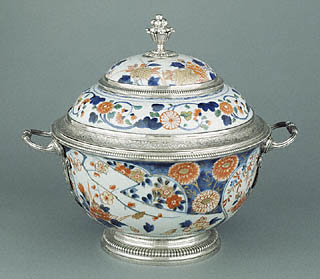• Describe this object. What materials were used to make this object?
• In what country do you think this object was made?
• What parts of this object seem to be Asian, and what parts seem to be European?
• Examine closely the patterned porcelain used in making this bowl. Do the patterns match each other exactly? What does this tell you about this piece?
• This object was made from a number of different Japanese bowls and plates. Can you identify the different objects used to make this piece and how they were put together? (There are three porcelain objects used to make this lidded bowl. The top is a small domed lid from a vase that has been cut down and fitted with silver mounts and a finial. The next stage down is a small shallow dish turned upside down. The two are fitted together with silver mounts to serve as a lid for the bowl below—also fitted with silver mounts, including handles.)
• Why do you think the French chose to change the function of the original porcelain objects? What function do you think it serves now that it has been altered? |
An as-yet-unidentified French silversmith constructed this covered bowl from three different pieces of porcelain imported from Japan. The European name for this type of porcelain was Imari, after the port in Japan from which it was shipped. The lid was made from an inverted plate, and a smaller lid was mounted in silver with a rim and finial. The bowl, plate, and small lid were all made as Japanese export ware. This particular style of porcelain was made in imitation of Chinese styles.
From the mid-1600s onward, larger quantities of porcelain from China and Japan began to be imported into Europe. In the 1700s, French dealers of luxury goods called marchands-merciers purchased the porcelain directly at auction or from the Dutch East India Company and passed it to metalworkers to decorate. Often the porcelain was modified and fitted with bronze or silver mounts, sometimes creating completely new forms. The practice of mounting Chinese porcelain in Europe goes back at least to the Middle Ages. These mounts were a tribute not only to the beauty of the material but also to its extreme rarity.
About Porcelain
Marco Polo was the first European to describe porcelain manufacture, and from the time of his return to Venice from China in the late 13th century, the Chinese high-fire ware became much sought after in Italy.
Porcelain is a type of ceramic highly valued for its beauty and strength. It is often called china, or chinaware, because it was first made in China. Porcelain is characterized by whiteness, a delicate appearance, and translucence (the ability to let light shine through). Porcelain is even used for electrical insulators and laboratory equipment. However, porcelain is known primarily as a material for high-quality vases and tableware, as well as for figurines and other decorative objects.
Porcelain differs from other types of ceramics in its ingredients and in the process by which it is produced. Two common types of ceramics—earthenware and stoneware—are made from a single natural clay, which is then fired (baked in a very hot oven). In many cases, the object is coated with a glassy substance called glaze. Firing at a low temperature produces earthenware, a porous (absorbs water) material. Earthenware can be made waterproof by glazing. Firing at a high temperature produces stoneware, a hard, heavy material that is also nonporous (waterproof).
Unlike earthenware and stoneware, porcelain is basically made from a mixture of two ingredients: kaolin and petuntse. Kaolin is a pure, white clay named after a location in China. Petuntse is a coarse clay. The word means "little white bricks" in Chinese. It is ground to a fine powder and mixed with kaolin. This mixture is fired at temperatures from about 2280°F (1250°C) to 2640°F (1450°C). At these extreme temperatures, the petuntse vitrifies—that is, melts and forms a nonporous, glassy matrix. The kaolin, which is highly resistant to heat, does not melt and therefore allows the item to hold its shape. The process is complete when the petuntse fuses to the kaolin. |
